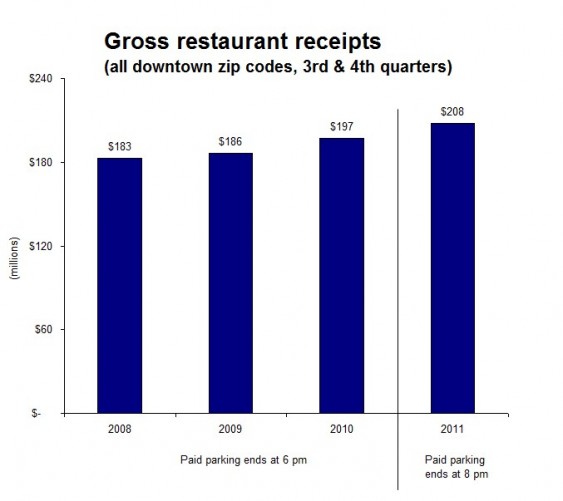Over the weekend, Seattle’s restaurant association took to the op-ed pages to complain about the City’s parking policies downtown. As they tell it, changes in parking policy “hits them where it hurts our businesses the most: their wallets.”
Yet as with so many discussions of parking, the restauranteurs’ argument is long on conjecture but extremely short on hard data. A look at gross receipts figures for downtown restaurants shows precisely the opposite of what the business group alleges. Their wallets appear to be doing just fine:
After paid parking hours were extended in mid-2011 gross receipts for downtown restaurants climbed by 5.4 percent.
The extension of metered parking from 6 to 8 pm went into effect in the middle of 2011, so by comparing the 3rd and 4th quarters of 2011 to the 3rd and 4th quarters of previous years we get a year-over-year comparison. To be sure, we should treat this analysis as preliminary, but the data we have so far suggest that in the era of higher parking costs business is practically booming.
On the one hand, it’s easy to understand why restaurant owners worry. A lot of these businesses skate by on thin margins, and proprietors may feel that parking changes could put their livelihood at stake. But on the other hand, it’s important to cross-check our beliefs with the data. And the data show that higher parking costs downtown have most definitely not led to a decline in overall sales.
How is that possible? Can higher parking costs actually boost business?
It may sound counter-intuitive at first, but on inspection it turns about to be totally sensible. By increasing turnover in on-street parking and ensuring that spaces are available for customers, well-calibrated parking policies really can increase patronage. (After all, would you rather grind through congested downtown streets in the rain while hunting for a parking space or pay a few bucks to stash the car curbside until 8?) In fact, boosting business is exactly what Seattle set out to do when officials adjusted meter rates and extended paid hours downtown.
Given the numbers so far, it looks like the City got it right. Receipts notched up in each of the three downtown zip codes. Sales rose by 2.2 percent in 98101 and by 8.7 percent in 98121. In the 98104 zip code, which encompasses the Chinatown/International District that has been the subject of so much hand-wringing over parking policy changes, business is stronger yet:
In the 98104 zip code, gross receipts spiked by nearly 9 percent after the parking changes went into effect. So, contrary to all the hullabaloo (and criticism of my earlier post on the subject), there’s little verifiable evidence that parking meters are driving business out of the southern part of downtown that includes Chinatown. If anything, the parking changes would seem to be increasing business.
Personally, I’m getting sick and tired of what seems like endless complaints about parking that are totally unsupported by data or analysis. Instead of anecdote and hand-waving, how about we all agree to spend more time examining the actual numbers?
The numbers I’m reporting here, by the way, are available to anyone. I got them by doing a public records request with the City. I was given aggregate gross receipts data by NAICS code for each of the three downtown zip codes for each quarter from 2008 through the end of 2011, the most recent available.
When you’ve got enough data on your hands, it’s usually possible to squint at it long enough to gin up some counter-story or oddity. But in this case, the receipts figures for downtown restaurants are reasonably clear: since paid parking hours were extended, business has increased, at least in aggregate. Plus, the aggregate data I’m reporting here is corroborated by the two other sources I’ve explored, sample data from the City for 14 establishments in Chinatown/International District and state Revenue Department data for the city as a whole.
In the future, I hope we can root our discussions in the actual numbers, and fewer data-free reactions from the restaurant association and Seattle Times. And if our debates about parking policy should ever graduate to the level of using actual numbers, then maybe we can start exploring more advanced topics like correlation and causation.
Notes: The data I use in the post refer to NAICS codes 722, 7221, 72211, 722110, 7222, 72221, 722211, and 722212. These are codes that refer to types of restaurants and they exclude places that are primarily drinking establishments. I also requested and received data for 722213 (“Snack and Nonalcoholic Beverage Bars”) but discarded it because the receipts figures are huge in 98104 but very small in the other zip codes. I assume that’s because 98104 includes at least one of the stadiums.
The timing of the extension of metered hours from 6 to 8 pm varied from place to place, and meter rates also changed in some places. In downtown proper, roughly consistent with 98101 and the northern part of 98104, parking rates also went up from $2.50 to $4.00 per hour and the changes took effect in April and May 2011. In Belltown, roughly consistent with 98121, parking rates declined from $2.50 to $2.00 per hour and the changes took effect in June and July 2011. In Chinatown/International District, a subset of 98104, parking rates did not change, but parking hours were extended starting in August 2011.




Comments are closed.